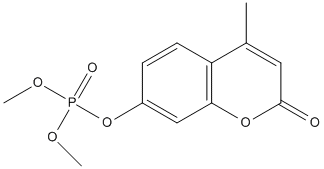dMUP
General
Type : Organophosphate || Coumarin
Chemical_Nomenclature : dimethyl (4-methyl-2-oxochromen-7-yl) phosphate
Canonical SMILES : CC1=CC(=O)OC2=C1C=CC(=C2)OP(=O)(OC)OC
InChI : InChI=1S\/C12H13O6P\/c1-8-6-12(13)17-11-7-9(4-5-10(8)11)18-19(14,15-2)16-3\/h4-7H,1-3H3
InChIKey : SVVSCEWVQSATRC-UHFFFAOYSA-N
Other name(s) : dimethyl 4-methylumbelliferyl phosphate, O,O-dimehtyl 4-methylumbelliferyl phosphate, SCHEMBL1023154
MW : 284.20
Formula : C12H13O6P
CAS_number :
PubChem :
UniChem :
Iuphar :

Target
Families : Carb_B_Arthropoda
References (3)
| Title : Organophosphate and pyrethroid hydrolase activities of mutant Esterases from the cotton bollworm Helicoverpa armigera - Li_2013_PLoS.One_8_e77685 |
| Author(s) : Li Y , Farnsworth CA , Coppin CW , Teese MG , Liu JW , Scott C , Zhang X , Russell RJ , Oakeshott JG |
| Ref : PLoS ONE , 8 :e77685 , 2013 |
| Abstract : Li_2013_PLoS.One_8_e77685 |
| ESTHER : Li_2013_PLoS.One_8_e77685 |
| PubMedSearch : Li_2013_PLoS.One_8_e77685 |
| PubMedID: 24204917 |
| Gene_locus related to this paper: helam-d5g3c9 , helam-d5g3d2 , helam-d5g3d3 , helam-d5g3d4 , helam-d5g3d5 , helam-d5kx87 , helam-d5kx99 , helam-d5kxa9 , helam-d9iv61 , helam-d9iv62 , helam-h9zvh4 , helam-s4wfz6 |
| Title : Hydrolysis of organophosphorus insecticides by in vitro modified carboxylesterase E3 from Lucilia cuprina - Heidari_2004_Insect.Biochem.Mol.Biol_34_353 |
| Author(s) : Heidari R , Devonshire AL , Campbell BE , Bell KL , Dorrian SJ , Oakeshott JG , Russell RJ |
| Ref : Insect Biochemistry & Molecular Biology , 34 :353 , 2004 |
| Abstract : Heidari_2004_Insect.Biochem.Mol.Biol_34_353 |
| ESTHER : Heidari_2004_Insect.Biochem.Mol.Biol_34_353 |
| PubMedSearch : Heidari_2004_Insect.Biochem.Mol.Biol_34_353 |
| PubMedID: 15041019 |
| Gene_locus related to this paper: luccu-E3aest7 |
| Title : Kinetic efficiency of mutant carboxylesterases implicated in organophosphate insecticide resistance - Devonshire_2003_Pestic.Biochem.Physiol_76_1 |
| Author(s) : Devonshire AL , Heidari R , Bell KL , Campbell PM , Campbell BE , Odgers WA , Oakeshott JG , Russell RJ |
| Ref : Pesticide Biochemistry and Physiology , 76 :1 , 2003 |
| Abstract : Devonshire_2003_Pestic.Biochem.Physiol_76_1 |
| ESTHER : Devonshire_2003_Pestic.Biochem.Physiol_76_1 |
| PubMedSearch : Devonshire_2003_Pestic.Biochem.Physiol_76_1 |
| PubMedID: |
| Gene_locus related to this paper: luccu-E3aest7 , musdo-EST23aes07 |